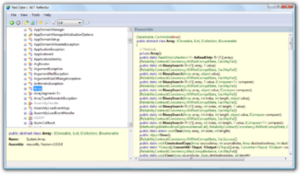.NET Reflector
 |
|
| Original author(s) | Lutz Roeder |
|---|---|
| Developer(s) | Red Gate Software |
| Stable release |
9.0.1.374 / 23 February 2016
|
| Operating system | Windows 7 or later |
| Platform | .NET Framework 4.5 or later |
| Type | Class browser and decompiler |
| License | Proprietary commercial software |
| Website | www |
.NET Reflector is a class browser, decompiler and static analyzer for software created with .NET Framework, originally written by Lutz Roeder. MSDN Magazine named it as one of the Ten Must-Have utilities for developers, and Scott Hanselman listed it as part of his "Big Ten Life and Work-Changing Utilities".
.NET Reflector was the first CLI assembly browser. It can be used to inspect, navigate, search, analyze, and browse the contents of a CLI component such as an assembly and translates the binary information to a human-readable form. By default Reflector allows decompilation of CLI assemblies into C#, Visual Basic .NET, C++/CLI and Common Intermediate Language and F# (alpha version). Reflector also includes a "Call Tree" that can be used to drill down into intermediate language methods to see what other methods they call. It will show the metadata, resources and XML documentation. .NET Reflector can be used by .NET developers to understand the inner workings of code libraries, to show the differences between two versions of the same assembly, and how the various parts of a CLI application interact with each other. There are a large number of add-ins for Reflector.
.NET Reflector can be used to track down performance problems and bugs, browse classes, and maintain or help become familiar with code bases. It can also be used to find assembly dependencies, and even windows DLL dependencies, by using the Analyzer option. There is a call tree and inheritance-browser. It will pick up the same documentation or comments that are stored in xml files alongside their associated assemblies that are used to drive IntelliSense inside Visual Studio. It is even possible to cross-navigate related documentation (xmldoc), searching for specific types, members and references. It can be used to effectively convert source code between C# and Visual Basic.
...
Wikipedia
